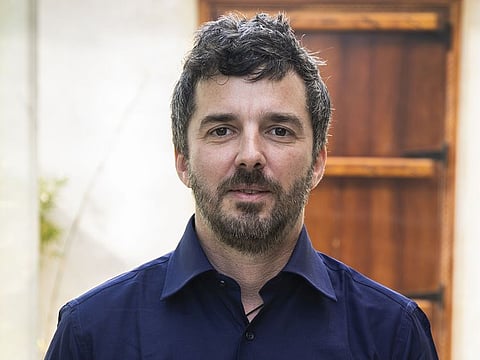Ras Al Khaimah Fine Arts Festival: A dialogue of art and nature
In conversation with Alfio Tommasini, Art Director and Curator, RAKFAF

Alfio Tommasini has a keen interest in the relationship that people have with the environment they live in. This is why he was so attracted to the RAK Fine Arts Festival. Curating an exhibition at the Al Jazeera Al Hamra Heritage Village – a historic site of clay, sand and corals – and the possibility for art to connect and interact with the elements on a new level, were among the other reasons.
Here are some insights on how Tommasini approached the process and the inspiration he hopes will be passed onto visitors of the Festival.
What is your inspiration behind this year's curation of RAKFAF?
My inspiration was just the feeling of the place. To see these constructions, the corals, how this past culture built with these materials coming from the sea. I tried to see what their nature was –what their connection with the elements was. It is interesting to immerse yourself as much as you can in the place because you create this interaction with it. Of course, you will pass many artworks, but it is always keeping in consideration where this artwork will end.
Sometimes it is interesting to create a contract with artwork coming from all over the world. You try to give space to a variety of visual languages. So, it is a question of immersing yourself in the place. I returned many times, taking time to learn what the place is communicating to you and that is, in the end, where the inspiration comes from.
How do you choose the artwork for RAKFAF?
The theme for this year is Discover your Nature. We received quite a lot of submissions. The process of selection was based on the quality of work, of course, but it was also based on the works aligned with the theme of the Festival. So, I looked for works that had a distinctive personal relationship of the artist with nature. For the curation, I tried to build a narrative on the site with a starting point.
You will see paintings, photography, and sculpture but there is a narrative and connection between images. So, you will discover an image and then walk to discover the next piece and its connection. I tried as much as possible to respect the site because it is not just about the artwork but creating a relationship with the place. So, it is not only about the images and artworks like in a museum, but it is a different approach.
It was always really important to consider and respect the place – to create a dialogue without being aggressive with the space. The site is very big, so this can be a challenge. But you do not need to follow a strict path. The beginning is the Fort. At the beginning you will see just images of vegetation. Then slowly you start to see human presence, which develops over the pieces of art.
How do events like RAKFAF help the community?
Art should not just be for people that are already working in the Arts sector. It should be a gateway for education and curiosity for the whole community. It is important to develop this type of initiative.
I like the fact that it takes place at a historical site. To understand the present, we must look into the past. This is a good example not just to mix contemporary art and promote new artists, but also give value to a site like this. It is very important for the Emirate and the whole community - that families and children can come to be simulated and engaged in both the art and the historical significance of the site.
I’m really pleased that RAKFAF is happening at Ras Al Khaimah’s historic Al Jazeera Al Hamra, which was an ancient pearling village – an enchanting site carved out of clay, sand and corals. It’s great to have the Festival in the village - thanks to RAKFAF, organisers and the creative works of all artists, visitors can explore a historical place that springs back to life again.
What can visitors expect at the 2023 RAKFAF?
The curation of art is only one major part of the RAKFAF. However, the organisers of the Festival will have various other engaging cultural festivities, outdoor film screenings, thematic events for family and children alike. I hope that people will feel this kind of immersion that you can have on the site with the images and other activities.
What is your personal favourite aspect of RAKFAF?
That’s a tough one! Well, I love the fact that RAKFAF is happening in a historical open-air site. I feel this nice energy on the site – there is a real interaction with viewing the art and walking in the sun and reflecting on the lives of the people who built this village.
Even if in simplicity, they were very creative and they built a sense of community where everything was connected with the elements. I have a lot of respect for the site, and that is why it is central when I am considering the narrative and artwork. Organising RAKFAF in this heritage village is a distinctive way to promote contemporary art and at the same time, give value to the history of the Za’ab tribe.
Any key message for aspiring artists?
More and more people are looking for unique experiences. That is why I like this Festival, which takes place in context. This is an interesting platform for the fusion of their work. RAKFAF is a great opportunity to showcase works from both local and international artists. I would encourage aspiring artists to take a look at RAKFAF as a place to submit their work. Besides exhibiting your art, the experience of participating will be a revelation.
Sign up for the Daily Briefing
Get the latest news and updates straight to your inbox


